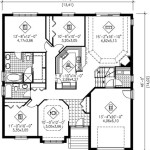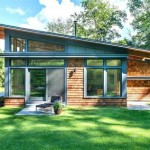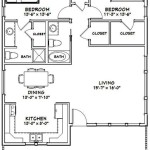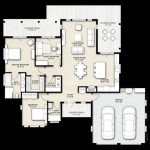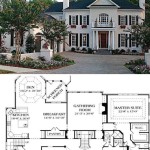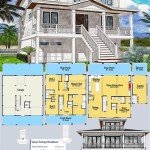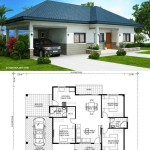The Enduring Appeal of High Ceiling Open Floor Plans
High ceiling open floor plans have become increasingly popular in residential and commercial architecture over the past few decades. This design aesthetic, characterized by expansive vertical space and minimal interior walls, offers a range of benefits and considerations for both occupants and designers. Understanding the nuances of this architectural style is crucial for those contemplating building, renovating, or simply appreciating its unique features.
An open floor plan, at its core, refers to the absence of walls separating traditional living spaces like the kitchen, living room, and dining area. This creates a unified, contiguous space. When combined with high ceilings, typically exceeding the standard 8-10 feet, the result is a visually dramatic and spatially generous environment. The appeal stems from a sense of freedom, enhanced natural light, and the potential for greater social interaction. However, careful planning is essential to maximize the advantages and mitigate potential drawbacks.
Understanding the Benefits: Light, Space, and Social Connection
One of the most significant benefits of a high ceiling open floor plan is the abundance of natural light. High ceilings allow for larger windows and the strategic placement of clerestory windows, which are set high in the wall to capture sunlight and distribute it more evenly throughout the space. This increased natural light can significantly reduce the need for artificial lighting, leading to energy savings and a more pleasant ambiance. Furthermore, natural light is known to improve mood, productivity, and overall well-being.
The perception of space is dramatically enhanced by high ceilings and open floor plans. The absence of walls creates a feeling of expansiveness, making even smaller homes feel larger and more airy. This can be particularly beneficial in urban environments where square footage is often limited. The vertical space provided by high ceilings also allows for creative design possibilities, such as the incorporation of tall bookshelves, statement lighting fixtures, or even mezzanine levels.
Open floor plans are conducive to social interaction. The seamless flow between living spaces encourages communication and togetherness. This is particularly appealing to families with young children, as parents can easily supervise activities while preparing meals or engaging in other tasks. The open layout also facilitates entertaining guests, as the host can remain connected to visitors while working in the kitchen or serving refreshments. The lack of physical barriers promotes a more inclusive and communal atmosphere.
Addressing the Challenges: Acoustics, Heating/Cooling, and Privacy
While open floor plans offer numerous advantages, they also present certain challenges that must be addressed during the design process. One of the most common concerns is acoustics. The absence of walls allows sound to travel freely throughout the space, which can lead to noise pollution and difficulty concentrating. This is particularly problematic in homes with hard surfaces, such as hardwood floors and tile backsplashes, which reflect sound rather than absorb it.
Effective soundproofing strategies are crucial for mitigating acoustic issues in open floor plans. These strategies may include the use of soft materials, such as rugs, curtains, and upholstered furniture, to absorb sound waves. Acoustic panels can be strategically placed on walls and ceilings to further reduce reverberation. The layout of the space can also be designed to minimize noise transmission, for example, by placing quiet areas, such as bedrooms or home offices, away from noisy areas, such as the kitchen or living room.
Heating and cooling can also be more challenging in high ceiling open floor plans. The large volume of air can make it difficult to maintain a consistent temperature throughout the space. Heat rises, which can lead to warmer temperatures at the ceiling and cooler temperatures at floor level. This can result in increased energy consumption and discomfort for occupants.
To address these heating and cooling challenges, it is essential to choose the right HVAC system and to implement effective insulation strategies. Radiant heating systems, which heat the floor rather than the air, can be particularly effective in high ceiling spaces. Ceiling fans can help to circulate air and distribute heat more evenly. Proper insulation in the walls and ceiling will minimize heat loss in the winter and heat gain in the summer, reducing the overall energy load.
Privacy can be another concern in open floor plans. The lack of walls can make it difficult to create distinct, private areas within the home. This can be particularly problematic for individuals who value their personal space or who work from home and require a dedicated workspace.
While complete privacy is not always possible in an open floor plan, there are several strategies that can be used to create a sense of separation and seclusion. Partial walls, screens, or curtains can be used to define different zones within the space. Furniture can also be strategically arranged to create visual barriers and delineate areas for specific activities. The use of different flooring materials or paint colors can also help to visually separate different zones.
Design Considerations: Scale, Proportion, and Functionality
Designing a high ceiling open floor plan requires careful consideration of scale, proportion, and functionality. Because of the large open space, furnishings must be appropriately scaled to avoid looking dwarfed or out of place. Too-small furniture in a large space can make the room feel empty and unfinished.
The proportion of the space is also important. High ceilings can make a room feel taller than it is wide, which can create an unbalanced aesthetic. To address this issue, designers may use horizontal elements, such as beams or wainscoting, to visually lower the ceiling and create a more balanced proportion. The placement of windows and doors can also affect the perceived proportions of the space.
Functionality is paramount in any design, but it is particularly important in open floor plans. The space must be designed to accommodate the various activities that will take place within it, such as cooking, dining, relaxing, and entertaining. Traffic flow should be carefully considered to ensure that people can move easily between different zones without disrupting activities. Storage solutions should be integrated into the design to minimize clutter and maintain a clean and organized aesthetic.
The choice of materials and finishes can also have a significant impact on the overall look and feel of a high ceiling open floor plan. Light colors and reflective surfaces can enhance the sense of spaciousness and brightness. Dark colors and matte finishes can create a more intimate and cozy atmosphere. The use of texture can add visual interest and depth to the space. The selection of materials should be consistent throughout the open area to create a cohesive and harmonious design.
Lighting plays a crucial role in defining spaces and setting the mood. In an open floor plan with high ceilings, a layered lighting scheme is often the most effective approach. This typically includes a combination of ambient lighting, task lighting, and accent lighting. Ambient lighting provides overall illumination for the space. Task lighting provides focused light for specific activities, such as reading or cooking. Accent lighting highlights architectural features or artwork.
High ceiling open floor plans offer a unique blend of aesthetic appeal and functional challenges. Careful planning and attention to detail are essential to create a space that is both beautiful and livable. By understanding the benefits and drawbacks of this architectural style, individuals can make informed decisions about whether it is the right choice for their specific needs and lifestyle. The enduring popularity of high ceiling open floor plans demonstrates their versatility and adaptability, making them a prominent feature in contemporary residential and commercial design.

Benefits Of Open Floor Concepts And High Ceilings Ameri Star Homes

Open Concept Modern Living Room

Luxury Contemporary Style House Plan 5074 Maclennon

Home

Open Concept Floor Plan With Vaulted Ceilings Rustic Kitchen Vancouver By My House Design Build Team Houzz Ie

Open Plan Loft With Amazingly High Ceilings

Pin Page

High Ceilings And Materials Are Prominent Design Elements In This New House

Cathedral Ceiling House Plans Small W High Ceilings

Adding Dramatic Impact With High Ceilings In Your Living Room The House Of Grace

